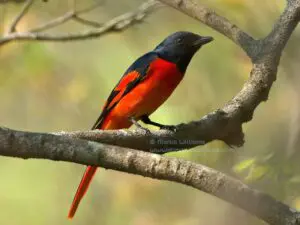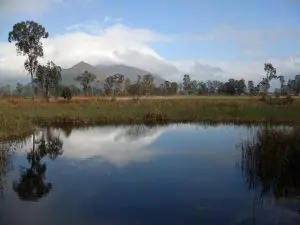As we (four researchers plus me) cruise the waters south of Lantau, scanning the sea for life but finding nothing other than occasional parties of gulls, Naomi Brannan chats matter of factly about her research work, and the current mission. Born and raised in Hong Kong, she studied for a master’s degree at Durham University, UK, and in 2017 submitted her thesis on studying how individual grey seals differ in their responses to stress. She returned to Hong Kong, and joined Sea Mammal Research Unit Consulting. Today’s outing is a survey focused on one of Hong Kong’s largest yet least known animals, the Indo-Pacific finless porpoise.
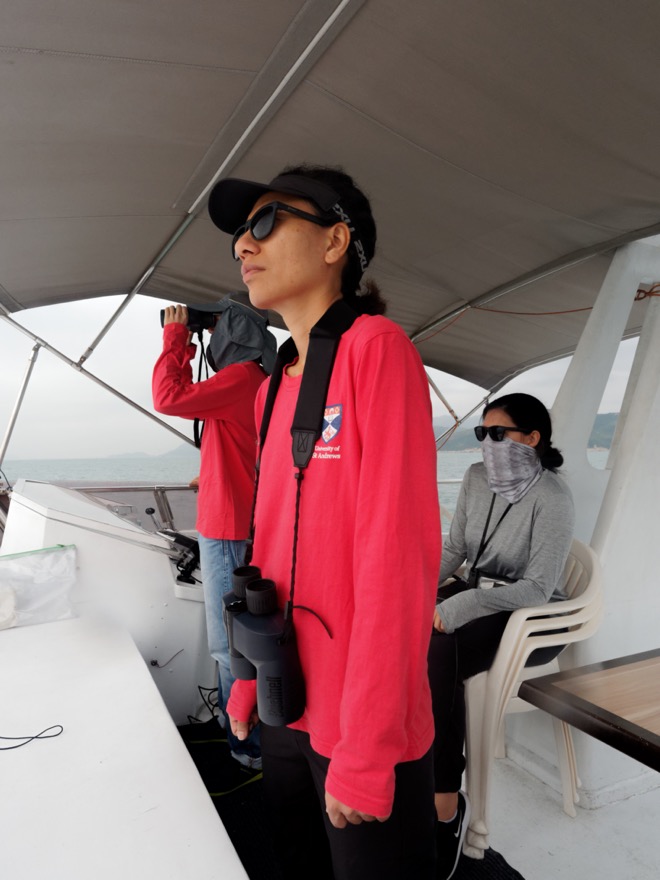
Brannan takes her turn as one of two lookouts on duty, gazing at waves stirred by an easterly breeze. Three times in recent weeks she has been on porpoise surveys like this; three times she has returned to shore without glimpsing even one. Suddenly, her calm demeanour is gone. “Porpoise!” she shouts. “There, in front of the boat!”
I look, but too late; the porpoise is already underwater again. But its brief appearance has already delighted Brannan. “I saw it – there was a little blow, two or three times, really close,” she announces to the three others, including me, on the top deck of the boat. Brannan spots another and
To some people, it might seem odd being so thrilled by briefly seeing a creature that typically looks like a dark grey tyre inner tube bobbing to the surface and vanishing, but this porpoise is special, partly as it’s one of just two porpoise species that lack a dorsal fin. While this gives it a minimalist profile at the surface, and it doesn’t leap from the water as dolphins sometimes do, photos of finless porpoises in captivity show they have faces with an almost cartoon-like cuteness. Their heads are rounded, with widely spaced, prominent black eyes, and mouths suggesting they’re perpetually smiling.
Smaller than Dolphins, Rarely With Them
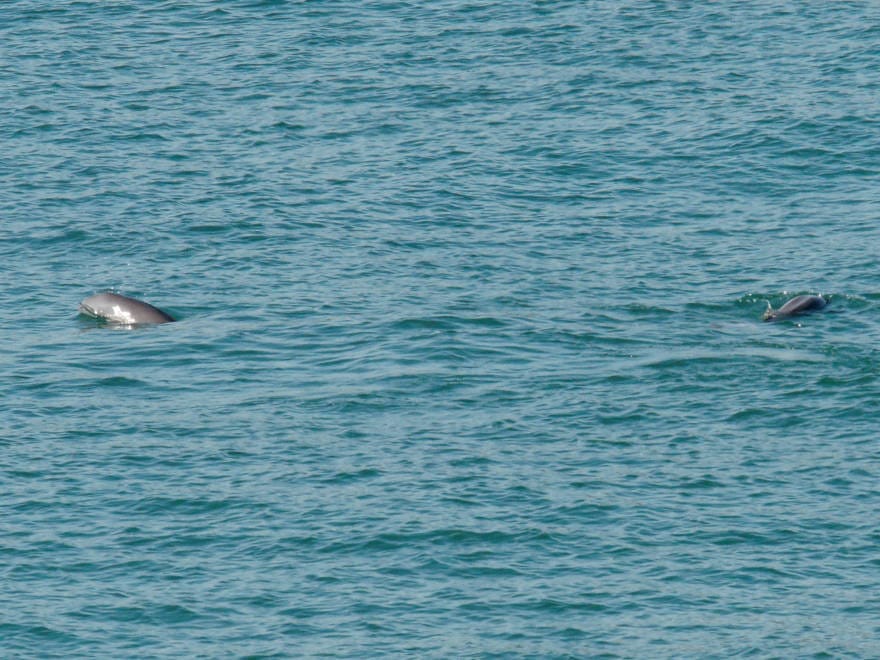
Indo-Pacific finless porpoises inhabit tropical coastal waters from the Arabian Sea east to south China. While no one knows the world population, they are nowhere abundant, and face threats including being trapped and drowned in fishing nets, leading to the finless porpoise being classed as Vulnerable in The IUCN Red List of Threatened Species. In Hong Kong, the porpoises are found in southern waters, and the best population estimate – based on surveys conducted around the turn of the century – suggests there may be around 200 here and in neighbouring Guangdong.
Growing to just 1.8 metres in length, according to information from the Hong Kong Dolphin Conservation Society, finless porpoises are smaller than their more familiar local cousin, the Chinese white dolphin, which can be up to 2.7 metres long. While the dolphin favours estuarine waters in the Pearl River mouth, the porpoise is more marine, and the only place you might expect to see the two species almost together is around the Soko Islands, off southwest Lantau.
From 1995 to early last year, the Agriculture, Fisheries and Conservation Department supported surveys by local marine mammal expert Samuel Hung and colleagues, which found that porpoises mostly occurred from the Sokos to southern Cheung Chau. Perhaps unsurprisingly, they mostly avoided high speed routes, favouring quieter places, such as the waters off southwest Shek Kwu Chau – which is the site chosen for the planned waste incinerator, dubbed by the government an integrated waste management facility (IWMF).
An artificial island will be created for the incinerator, and given this could impact the finless porpoises, the contractor – Keppel Seghers Zhenhua Joint Venture, has commissioned surveys to assess how they respond while work proceeds. These include today’s outing by the Sea Mammal Research Unit team.
Rather than randomly roaming the sea, the team is following a set pattern, using GPS measurements to determine the start and end points of eight north-south transects, each around two kilometres long. The first of these began perhaps a kilometre east of the Sokos, and the porpoise sighting that so thrilled Brannan was around the end of the fourth transect, in open water several hundred metres southwest of Shek Kwu Chau.
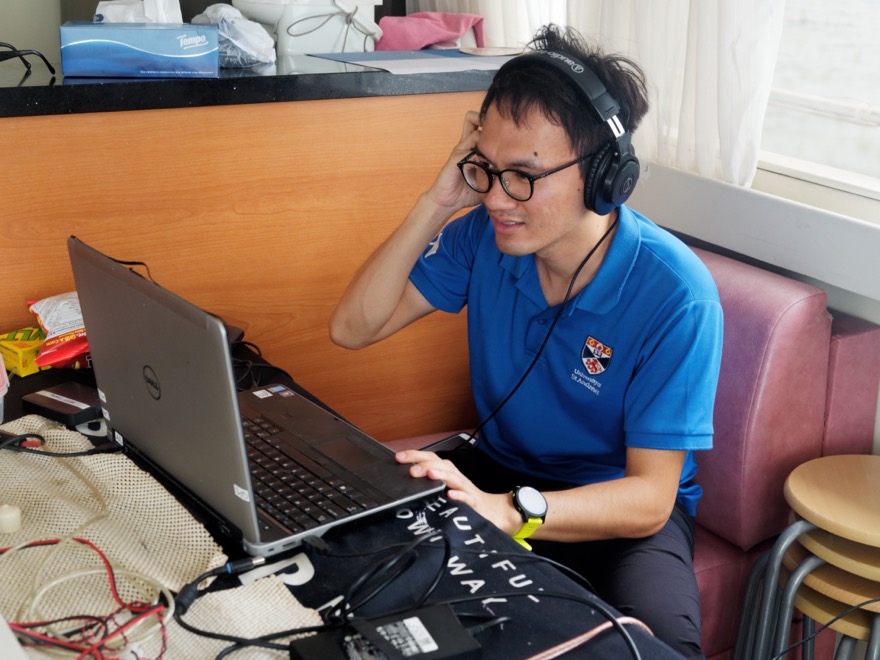
Porpoises use echolocation to find food like fish, shrimps and squid, emitting a stream of clicks above the range of human hearing. To help detect them, the team is towing a hydrophone behind the boat, and research technician Arthur Lee sits at a table indoors, using headphones to monitor sound modulated to suit human hearing. “I heard them clearly,” he reports via walkie talkie.
Past the Future Incinerator Site
Another transect takes the boat past the future incinerator site, where work is underway on early stages of the reclamation. A couple of barges are equipped with rigs and booms; another appears specialised for driving piles into the seabed. A moored dredger is loaded with sand.
There’s no surprise at neither sight nor sound of porpoises here. Yet this was one of their favoured locales in Hong Kong. During “baseline monitoring” from 30 January to 14 May last year – which actually overlapped with preparations for reclamation – finless porpoises were frequently sighted here until the second week of March, when boats and construction platforms arrived to begin seabed assessments. Afterwards, the finless porpoises were essentially absent from the planned reclamation area.
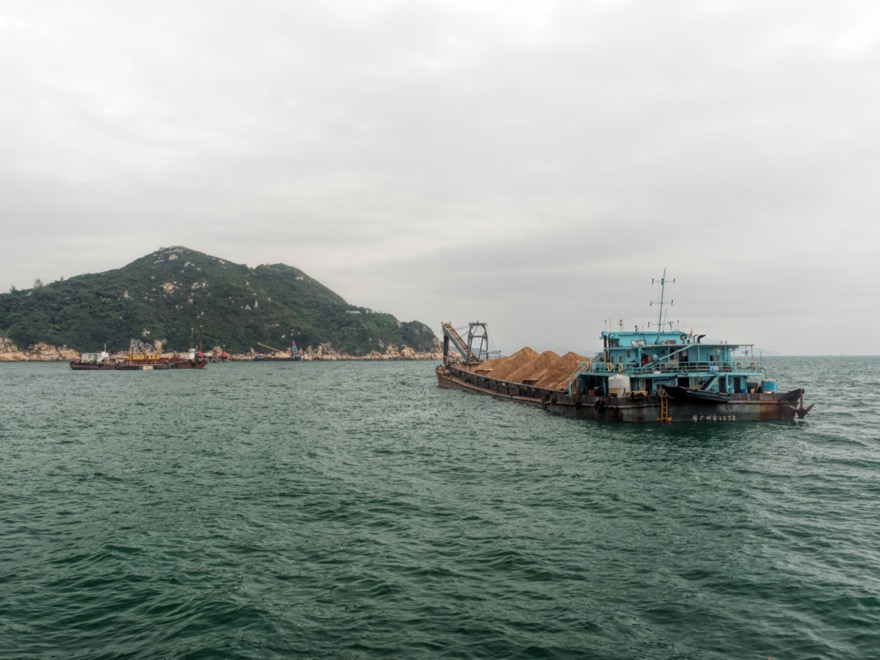
An environmental impact assessment on selecting site for the incinerator did anticipate the porpoises would be disturbed like this if it was built by Shek Kwu Chau, but confidently predicted mitigation measures would keep any adverse impacts to an “acceptable level”. This is not a view shared by conservationists including Taison Chang, the chairman of Hong Kong Dolphin Conservation Society, who told me via email: “We don’t agree there will be no significant impact on finless porpoises from the construction of the incinerator,” adding that the huge impact during the ground investigation work, “shows that the real construction process will have a larger impact on finless porpoises when there are more working vessels and noise. Shek Kwu Chau is proven to be a critical habitat in Hong Kong waters for finless porpoise.”
The main mitigation measure propose is creation of South Lantau Marine Park, to include waters west of Shek Kwu Chau and around the Sokos. However, work on establishing this has been slow partly because of objections from some nearby villagers, and Chang notes issues such as marine traffic routes remaining open so the threats to porpoises will remain. Plus, experience with the Chinese white dolphin reveals marine parks are no magical panacea for disturbance from development – as two such parks were established for the dolphins north of Lantau, yet during work on the Hong Kong–Zhuhai–Macau Bridge dolphin numbers plummeted, and individuals moved southwest, leaving these supposed sanctuaries almost bereft of dolphins.
Perhaps it’s a bad sign that last year, 33 dead finless porpoises were logged by Ocean Park Conservation Foundation, equalling the previous record high set in 2014, and representing 12 percent of the tally since the foundation started investigating stranded dolphins and porpoises in May 2006. As yet, it’s too early to tell if there has been an uptick in deaths due to the reclamation work; Chang advises, “We will need to keep an eye on the number in the following years.”
South of Cheung Chau, the boat turns to start another transect, and there’s again a shout of “Porpoise!” and this time I just see one, a steely grey shape that bobs up amidst the waves, and is lost from view again. The spotters see two, which are duly recored. A couple more transects follow after this, between Shek Kwu Chau and Cheung Chau, but without even a hint of a porpoise.
So a morning’s work has yielded four
Advice on Spotting Porpoises
While it’s not easy to see finless porpoises, they can sometimes be spotted from southwest Cheung Chau, perhaps feeding close inshore. Here, you can follow a path from Sai Wan Tin Hau Temple, past Reclining Rock to Pak Tso Wan [not so easy if it’s high tide]; where the fine scenery makes for a worthwhile walk even without porpoises.
You could also book a sampan to search south of Cheung Chau and near Shek Kwu Chau, maybe even with a visit to the Soko Islands, such as via Tina Wong tel/whatsapp 62774179. For further information, visit the website of Hong Kong Dolphin Conservation Society http://hkdcs.org/.
[Written for the South China Morning Post]






